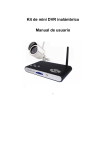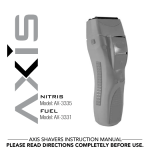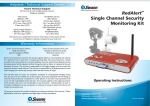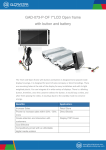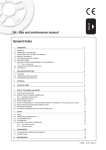Download AT&T ATT 1465 - 1465 2.4 GHz Analog Cordless Phone User manual
Transcript
Wireless Mini DVR Kit User Manual 1 Table of Contents 1. Package Contents………………………………………… 3 2. Overview…………………………………………………… 4 3. Layout of the DVR…..…………………………………….. 5 4. About the Camera.………………………………………… 6 - 7 5. Connecting Power and Cameras……………….…………8 6. Attaching the DVR to a Television…………….….……… 8 7. Motion Detection…………………………………………… 9 8. Viewing Live Images………………………………………. 9 9. Capture Format and Quality Settings……………………. 10 10. Wireless Cameras and Interference……………..………11 11. Motion Detection Settings…………………..…………….12 - 13 12. Playback Images and Videos………………………..…...14 13. Accessing Images/Videos via a Computer…………..….15 14. Troubleshooting…………………………………………... 16 - 17 15. Tips and Tricks……………………………………………..18 16. Technical Specifications………………………………,,…19 2 1. Package Contents INCLUDED: → Wireless DVR Receiver/Recorder → Instruction Manual → DVR Power Supply (5V) → Video In Cable → Video Out Cable → Wireless Camera → Camera Power Supply (12V) → SD Card (2GB) 2. Overview Congratulations on your purchase of the wireless DVR! This single channel video recorder is a terrific value for money security solution, as well as being easy to install, use and transport from location to location. Practically fitting into the palm of your hand is a neat feature as well! Before we get into the nitty-gritty of learning how to install, configure and use the wireless DVR, let’s just take a moment to discuss its features, strengths and limitations, so you can get the most out of your Wireless DVR. ) How it Works 1 The wireless DVR will record video or still images directly to an SD 3 card, and it can be configured to do this whenever it detects motion in the view of its camera. It is an ideal monitoring solution for guarding specific security vulnerabilities around the home or small office. Some suggested applications include monitoring the front or back door, a main hallway, or a courtyard or balcony. If there is a single, specific location that you wish to safeguard, the wireless DVR is the perfect solution. By correctly configuring the motion detection settings, and using a large SD card you can get the wireless DVR to function autonomously for up to months at a time! ) 2 A few key points to remember: → The wireless DVR requires high-quality, high-speed SD cards to function correctly. Cheaper SD cards have slower write speeds, and can’t keep up with the wireless DVR. Digital video requires a massive amount of data -so make sure you use the highest quality, highest speed cards available. The Wireless DVR is compatible with the SD and SDHC standards. → The wireless DVR can monitor a maximum of two cameras at once (one of which must be wired, the other one wireless) but can record only one at a time. Savvy users might have already noticed that the wireless DVR has four wireless channels – the wireless DVR is not recommended for multiple wireless cameras! See page 11 for more information about why we’ve included multiple camera channels. → Though it is remarkably efficient hardware for its size and cost, the wireless DVR is a miniature, self contained, entry-level video recording unit. It will (unfortunately) not operate like the mythical technology shown on television shows like CSI or 24 (we really wanted it to, but it turns out that sort of technology costs millions of dollars and doesn’t 4 really work that well in real life, anyway). Bear this is mind when placing your camera(s): the closer the camera is to the action you want to capture, the more detail you’re going to get. For example, if you want to capture a vehicle registration tag, you’ll have to have the camera within about a dozen feet (about 4 meters) from the vehicle to capture the required detail. → The Wireless DVR is a single channel recorder. It will only record one video/ image at a time. When using motion detection and picture-in-picture mode, the wireless DVR will automatically switch between the wired and wireless cameras to record whichever of the two cameras detects motion. → If you’re using your wireless DVR with a wireless camera, be sure to read the section on page 11 on interference and how you can avoid it when you configure your system. 3. Layout of the DVR 5 CH1, CH2, CH3, CH4: Displays which wireless channel the wireless DVR is configured to receive. This is in no way automated, and the wireless DVR will only receive images from one wireless camera at a time. To change the channel that the wireless DVR is monitoring, press the SW button. SW: Changes the wireless channel that the Wireless DVR 2 will monitor. This is the only way to change the wireless channel – there is no function to cycle automatically, as the wireless DVR was, simply, not designed for use with multiple wireless cameras. MODE: Switches between RECORDING MODE and PLAYBACK MODE. REC: Commands the wireless DVR to capture a still image or video immediately, using the current recording mode and quality settings. In PLAYBACK MODE, it acts as the play / pause button. DISP: Changes the viewing mode between wired and wireless cameras, and engages PIP MODE. ZOOM: Increases the digital magnification of the image coming from the wireless DVR. Press multiple times to scroll through magnification options. Use the arrow buttons whilst zoomed in to move the view around the image. In PLAYBACK MODE, this acts as the stop button. ARROWS: Used to navigate when in the MENU, and as SHORTCUT buttons at other times. 6 (Enter): Used to enter the MENU, and to select items whilst in the MENU. SD CARD SLOT: Where you put the SD cards you want to record to. The wireless DVR can record to cards conforming to the SD and SDHC standards. Be sure that the write protection tab on the SD card inserted is set to off. 4. About the Camera The camera supplied with your DVR is a miniature yet versatile camera. It is a weather resistant, analog wireless camera which can be used indoors or outdoors. It captures color images by day and black & white at in the dark using its built-in infrared LEDs to achieve night vision with a 26ft/8m range. The three most important things to consider when placing your camera are: 1. Where you want to survey, and how much detail you want to see. The camera has a fixed lens, meaning that it’s field of view can’t be altered. This means that what the camera will be able to see will be completely determined by where it is placed. The closer the camera is to the action you want to see, the more detail there will be in your images. 2. Protection from the Heat and Moisture 7 The wireless camera is weather resistent, not weatherproof. Long term exposure to moisture (rain or condensation) or direct sunlight will have a negative impact on the cameras performance, and may stop it working altogether. The power adaptor and power cables, however, are not weather resistant at all. Do not expose these to moisture of any kind. We recommend installing the camera in sheltered locations only, where it will be protected from the majority of moisture and sunlight, such as under an awning. 3. Interference In much the same way that your mobile phone or the radio in your car loses its signal in some locations, the wireless transmitter in your camera can have a hard time communicating with the DVR from some locations. We suggest testing this -before permanently fixing the camera in place, check the signal that the DVR can detect from it. Remember: The Wireless Camera is not cordless, and needs to be connected to power via the supplied power adaptor. Powering the camera via batteries is not a suitable long term solution, as most batteries will be drained within a few hours of being connected. This is due to the large power requirements of digital image sensors. The term ‘wireless’ refers to there being no cable between the camera and the DVR. 8 To Install the camera: 1. Select the position for your camera If the DVR has already been attached to a TV, you can attach the camera to power and check both the cameras view and the level of interference at the same time (see page 11 for more information on wireless interference). 2. Mount the camera Use an appropriate screw type for the surface you’re mounting the camera to. Make sure the lens is upright relative to your subject -you can tell easily as the antenna should be relatively upright. 3. Connect the camera to power via the supplied power adaptor. Remember that the power adaptor and power cables are not weather resistant, and need to be sheltered from moisture, rain and sunlight. 4. Set the camera’s channel The camera can transmit its images on one of four channels. To set the channel: 1) Lift the small tab on the side of the power cable. 2) Locate the two dip switches locate underneath. 3) Using a toothpick or similar, flip the dip switches to the desired configuration, as listed. 9 5. Connecting a Wired Camera In addition to the supplied wireless camera (or instead of it, if you’d prefer) the wireless DVR can also monitor and record from a wired camera (though not record both simultaneously). To install a wired camera: 1) First, ensure that you have enough cable to install the camera in the location that you desire. You can use additional longer extension cables if necessary. 2) Connect the camera to the power. 3) Attach the Video Out cable from the camera to the A/V In cable. 4) Attach the AV In cable to the port marked A/V In on the rear of the wireless DVR. 5) Press DISP to change between viewing the wired and the wireless channels. 10 6. Attaching the wireless DVR to a Television To connect the wireless DVR to a television: 1) Be sure you’ve already connected the wireless DVR to power using the supplied power adaptor (9V). 2) Using the supplied RCA A/V out cable, attach the AV OUT on the back of the wireless DVR to the Yellow (Video) and White (Audio) plugs on the back of your television. Make sure the the plugs and the inputs are the same color. Tips and Tricks: Be sure to plug the RCA connectors into INPUTs on the back of your TV (or front, if your TV has them there). Watch out for VIDEO OUTPUTS, which many TVs come with. 11 7. Motion Detection If the wireless DVR recorded everything it saw all the time, you’d wind up with hundreds of images (or hours of video) where nothing is happening! That’s not very useful for anyone, as it would fill up the SD card too fast, and leave you searching through hundreds (or more) files to try and find the incident you are after! Thus, to save storage space – not to mention your time and sanity – the wireless DVR is designed to record short videos (5 or 10 seconds in length) or take a series of still images whenever something happens in view of the camera. We call this MOTION DETECTION. To turn MOTION DETECTION ON or OFF: 1) Press to enter the menu. 2) Use LEFT and RIGHT to navigate to the MOTION DETECTION 3) 4) submenu. Press to toggle MOTION DETECTION to ON or OFF, depending on your preference. The MOTION DETECTION icon will be displayed in the top left of the screen whilst enabled. 5) We’ll cover the other settings later. 12 8. Viewing Live Images By default, the wireless DVR will boot up straight into LIVE VIEWING MODE. The DISP button will cycle between displaying a WIRED and a WIRELESS camera connected to the wireless DVR. The wireless DVR is capable of displaying images from two cameras at a time. To achieve this, one of the cameras must be wired, the other wireless. As the picture from one camera is displayed in miniature within the other camera’s picture, this is referred to as Picture In Picture mode (PIP MODE) . 1) Press DISP once to switch between the WIRED and WIRELESS camera. 2) Press DISP again to activate PIP MODE. 3) Press DISP a third time if you wish to swap the positions of the main and miniature images. 4) Note that whilst the wireless DVR can display two images at once, it can only record one at a time. When the wireless DVR is recording, the channel being shown full-screen is the one being recorded. You may experience a drop in frameframe-rate when using PIP mode. This is due to the extra processing power that displaying two images at once requires. This frameframe-rate reduction can affect both live monitoring and video recording. recording. 13 9. Capture Format and Quality Settings The wireless DVR can record in one of two formats: it can either record still images (in JPEG format) or 5 or 10 second video recordings (as AVI files). To change the CAPTURE FORMAT: 1) Press to enter the menu, and press LEFT or RIGHT to navigate to the Motion Detection menu. 2) Use UP or DOWN to select Capture Mode, and press . 3) Choose the format you would like, and press to confirm. 4) Select EXIT to leave the menu. About these file types: JPEG (often just JPG) is a very standard compression format, retaining most perceivable detail in an image, whilst vastly reducing file size. It is the most common type of compression used for images distributed via the Internet. The high compression ratio allows many hundreds of images to be stored on the supplied SD card. Any recent computer of any type will be able to read .JPG files. (The name JPEG comes from the Joint Photographic Experts Group who developed the standard.) AVI is a popular video format, which is highly compatible with most computers and computer-like devices (such as recent mobile phones 14 and even video game consoles). AVI is an acronym for Audio Video Interleave, and has been a popular video ‘container’ for many years. The term ‘container’ means that it is a type of file which holds video data, rather than specifying exactly what kind of video data it should hold. Quality Settings The wireless DVR has selectable quality settings. You can record still images in HIGH, STANDARD or LOW QUALITY. You can record movies in D1 or QVGA QUALITY. D1 quality will record a full-frame analog TV signal at 720 x 480 pixels (NTSC) or 720 x 576 pixels (PAL), whilst QVGA will record an image with half the vertical and horizontal resolution. LOW QUALITY conserves space on your SD card at the expense of image quality. The upside of LOW QUALITY is that you can store many more images/videos on your SD card – though these recordings will not look as clear as those recorded in HIGH QUALITY. STANDARD QUALITY offers a balance between these two concerns. To change your QUALITY settings: 1) Press , and using the LEFT/RIGHT buttons, navigate to ADVANCED SETTINGS. 2) From the ADVANCED SETTINGS menu, select PHOTO or MOVIE QUALITY. 3) Choose the quality setting you would like, and press . 4) Select EXIT to leave the menu and save your changes. 15 10. Wireless Cameras and Interference If the image coming from your wireless camera is distorted, you’ve probably discovered the bane of analog wireless technologies: interference. To help you get as much out of your wireless DVR system as it’s capable of delivering, here’s a brief rundown of what interference is, and how you can try to minimise it. The Wireless Camera transmits its images on a radio frequency of 2.4GHz. This is way over the range of the average radio, but there are some (in fact, many) devices out there that transmit data on this frequency. Things such as wireless computer networks, cordless phones, baby monitors, car alarms and Bluetooth enabled devices communicate at and around a frequency of 2.4GHz. Other devices, such as microwaves, create radio “noise” at this frequency as well. Placing your cameras or wireless DVR near these devices, or having any of these devices in between your cameras and receiver, can cause interference and affect picture quality. This happens because the signals are so similar, that they get mixed up with one another, and your receiver will have trouble figuring out which is which. If you want to visualize how interference occurs, imagine playing two games of football simultaneously on only one field. The players will continually collide with one another, and occasionally forget which ball is which! Naturally, when two games are played at the same time on the same field, both games suffer, take longer to play and neither team will score as often as they should. This is exactly what happens when two wireless devices are used too close together! To discover what might be causing your interference, we suggest disconnecting all other wireless devices one at a time to find out which one is causing the problem, and adjusting your setup accordingly. Bear in mind that a wireless device from nearby homes or businesses 16 could be the culprit, and other than asking neighbors politely to turn it off, there’s little that can be done about this problem. If you are experiencing interference or poor image quality try the following steps: 1) Try moving the camera to a different location, or, if it really is exactly where you want it, changing the orientation of the antenna on the camera and the wireless DVR. 2) Adjust or aim the receiver antenna - a single inch can make all the difference. 3) Limit the number of walls, floors between the camera and receiver as this can dramatically alter picture quality. 4) Dense materials such as concrete or metal will impede the wireless signal; try moving the camera and/or receiver away from dense materials. 5) If possible, keep the camera and receiver away from or move conflicting devices such as wireless routers, microwaves, cordless phones. Some environments are simply not suitable for analog wireless systems. If this is the case in your environment, consider changing to a wired camera or to a digital wireless system, as these are not subject to interference in the same way as analog wireless systems. 17 11. Motion Detection Settings Say you’re monitoring your yard, and right next to the gate you want to watch there’s a tree blowing in the wind, which constantly triggers the motion detection. Perhaps you’re watching a hallway, and your pet cat continually sets off the motion detection, and you only want to record humans. What can you do? You can fine tune your MOTION DETECTION settings to only trigger the wireless DVR to record when it should! There are several settings you can configure, and we’ll go through them one at a time. But first, we’ll examine how motion detection works. If you’re using motion detection and PIP mode at the same time, the wireless DVR will automatically change the primary camera being displayed/recorded if it detects motion on the camera not currently selected. How Motion Detection Works Motion detection is a process undertaken by the wireless DVR based solely on the image it receives from the camera. There are no external sensors to connect, nor does the camera send a signal to the wireless DVR telling it to record -the wireless DVR ‘watches’ the image from the camera, and detects differences between frames. A frame is one still image -if you play them quickly enough, one after another, it gives the illusion of full motion. A single frame is displayed for between 1/25th and 1/30th of a second. This means that when the wireless DVR is looking for ‘Motion’ what it’s really looking for is a change in the picture, specifically, counting how many pixels (the individual dots that make up an image) change from one frame to the next. This includes pixels changing colour, brightness or any combination of the two. Thus, something does not necessarily have to ‘move’ in frame for the wireless DVR to detect ‘motion’. For example, sudden changes in 18 lighting conditions (such as turning a light on or off, a moving object throwing a shadow into the field of view or the sun being swiftly covered by clouds) can trigger the wireless DVR to record. However, if you follow the subsequent instructions on customising your Motion Detection settings, you should be able to avoid a good many false alarms. Enabling / Disabling Motion Detection: As covered earlier, the first setting in the MOTION DETECTION menu is whether or not it is enabled. When motion detection is not enabled, the wireless DVR will only record when the REC button is pressed. We suggest that motion detection is typically the best solution for long term monitoring. Sensitivity: The amount of motion that the wireless DVR requires to trigger a recording can be customised. There are sixteen (16) levels of sensitivity, with 1 being the most sensitive and 16 the least. 19 Typically, a value somewhere in the middle of the range is a good choice (somewhere between 5 and 10 is suggested). This is usually sensitive enough to pick up the majority of significant events but not so sensitive that your SD card will fill up with numerous false alarms! The best way to tweak the sensitivity is by trial and error. Set the value to somewhere near 8, and then walk in front of your camera, impersonating the path of a potential security risk. If the wireless DVR does not record you doing so, lower the sensitivity value. If the wireless DVR starts recording when you’re not in the picture, then raise the value. Detection Range: If you have some continual motion in view of the camera, such as a busy road or a tree blowing in the wind, then you’ll need to define which part of the screen you want to be sensitive to motion. You can choose the whole screen, a quarter of the screen or 1/16th of the screen. Once you’ve selected the size of the sensitive area, you’ll be taken to the Detection Range Placement screen. The area that is sensitive to motion will be represented by a green square. Use the arrow buttons to move the green square to a position which suits your situation. Press when you’re done. 20 12. Playing Back Images and Videos There are two ways to view images and videos captured by the wireless DVR. One way is to view them through the wireless DVR (and the TV that the wireless DVR is connected to) and the other is to simply take the SD card out of the wireless DVR, and insert it into an SD card reader attached to your computer. To Playback images/videos using the wireless DVR: To access PLAYBACK MODE, press the MODE button. You will be taken to the most recently recorded video/picture. The bottom left-hand corner of the screen will show the date and time that the file was recorded. The lower right-hand corner will show the folder name (determined by the date) and the file name (determined by the time) of the recording you’re viewing. The controls in PLAYBACK MODE are: REC: Play / Pause the current recording. ZOOM: Stops the current recording during playback. When stopped, ZOOM will open the thumbnail view, where you can navigate through recordings using the arrow buttons. Press to select a recording for playback. Note: When stopped but not in thumbnail view, you can navigate using the arrow buttons. You’ll move between recordings as though you were in thumbnail view (ie. LEFT / RIGHT move back and forth one item, and UP / DOWN move between rows). This can be a little tricky to get the hang of initially, so we strongly recommend using the thumbnail view accessible using the ZOOM button. 21 To change folder: Press ZOOM whilst in the thumbnail view. You will see a series of folders listed by date. Simply use the arrow buttons to navigate to the date that you want, and select it by pressing . . To DELETE unwanted images/videos: 1) Whilst in PLAYBACK mode, navigate to the video/photo you want to delete. have open when you pressed 2) While it is selected but not playing, press . 3) You will be taken to the PLAYBACK menu. 4) Select FILE DELETE. 5) You can choose to delete a SINGLE FILE, which will only delete the file you press . 6) Alternately, you can delete ALL files, which will remove all files on your SD card which were recorded by the RedAlert2. To do this, choose ALL and press , When asked to confirm, choose YES and press . 13. Accessing Images/Videos via a Computer One of the most convenient aspects of recording to an SD card is that, if you have an SD card reader for your computer, you can simply pop the SD card into it and open the RedAlert2’s images/videos directly. 22 To Format the SD Card: 1) Formatting the SD Card will erase all data, and re-write the file allocation table (FAT). This is especially useful if your SD card is not detecting the correct amount of free space. 2) Select FORMAT from the playback menu and press . When asked to confirm, choose “Yes” and press .The wireless DVR will take a few moments to process this. Afterwards, your SD card will be completely free of data, ready to continue recording in the wireless DVR. To playback, copy and delete images using a computer: 1) Place the SD card into your computer via an internal or external card reader. 2) Open the SD card in your computer’s file browser. You’ll see a folder dedicated to each day that the wireless DVR was operating. 3) All recorded images and videos are stored as separate files numbered in chronological order of when they were captured. 4) You can cut and paste the wireless DVR’s images/videos in the same manner as any other file. 5) To delete files, drag them to the Trash/Recycle Bin (depending on your operating system) or highlight them and press your computers Delete key. A popup box will ask you to confirm. 6) Most current systems will have no problem opening the file types that the wireless DVR creates. If you encounter problems, update your video player or image viewing software. If you’re having trouble playing back the videos created by the wireless DVR, consider downloading VLC Media Player. There are versions of VLC available for Windows, Mac OS and just about every other operating system you can imagine. It is available free online, at http://www.videolan.org/vlc/ 23 Note: It is not possible to directly connect the wireless DVR to a computer. However, with the ease of transfer of data via the SD card, there really isn’t a reason to. 24 14. Troubleshooting Problem: I can’t record images from two cameras simultaneously! Solution: This is not a malfunction -the wireless DVR can only record one camera at a time. While it is possible to monitor two cameras at once (one wired, one wireless) it is not possible to record both at once. If using PIP (Picture in Picture) MODE, the wireless DVR will automatically switch between cameras to record whichever one detects motion. Problem: The wireless DVR will only pick up one of my wireless cameras. Solution: Whilst the wireless DVR can be tuned to four wireless channels, it can only monitor one of them at a time. There is no automatic switching function: if you want to change the wireless channel that the wireless DVR is monitoring, you need to do this manually by pressing the SW button. For this reason, we do not recommend using multiple wireless cameras with the wireless DVR. roblem: The picture quality is poor when I use a wireless camera, or P so distorted as to not qualify as a picture. Solution: Your camera’s signal is probably suffering from signal blockage or interference. Try realigning the antennas (sometimes an inch can make all the difference) or moving the wireless DVR itself. You may need to try moving the camera, as well. If this does not help, you may need to shut down other wireless equipment operating nearby to the wireless DVR. Problem: There seems to be a red haze in picture. Solution: This is most likely caused by a strong light source (such as 25 the sun) shining directly into the lens of the camera. This is simple to remedy: face your camera away from light sources, or use a lens hood for the camera to stop light entering the lens directly. Problem: The foreground is too dark, whilst the background is too bright. Solution: The wireless DVR uses automatic exposure adjustment to keep the majority of the image correctly lit up, without you having to adjust anything. However, this means that if what you want to see is in shadow when there’s something else in full sun in frame, the shadowy areas might black-out altogether. The best solution is to make sure that the majority of the cameras view (particularly the centre) is taken up with the lighting conditions you want to see detail in. The automatic exposure will do the rest! Problem: All I see at night is black! Solution: Whilst the wireless Camera which comes with the wireless DVR has limited night vision, it is just that: limited. The camera uses infrared LEDs to “see” in the dark (infrared is a type of light that human eyes cannot see) the range is limited to approximately 26ft/8m. If there is nothing within that range, the camera will see nothing! Also, darkly coloured objects (such as a black car) may not reflect enough infrared light for the camera to see them clearly. The best solution is to simply move the camera closer to what you want to see. Problem: The camera is looking out a window, and at night all I can see is white! Solution: The camera uses infrared LEDs to see at night. However, infrared light will reflect off a glass surface, and bounce-back into the lens of the camera, washing out the image. It is not possible to use an infrared night vision camera to look out of a window. If you want to see 26 outside, the camera has to be outside as well. Problem: The wireless DVR is not capturing pictures/videos when it should, or it captures pictures/videos too often! Solution: Your MOTION DETECTION SETTINGS need adjusting. Basically, you can define how the wireless DVR will look for motion, and how much motion it must detect before it initiates recording. If you’re using a wireless camera and the wireless DVR is capturing pictures/video too often, it might be the case that there is enough interference in the video signal to count as motion. Problem: All I see is a blank screen. Solution: Check the connections between the wireless DVR and your TV -in particular, check which RCA connection on the TV has the VIDEO OUT cable attached to it. Many TVs have A/V INPUT channels and A/V OUTPUT channels. Plugging the VIDEO OUT cable into an A/V OUTPUT will produce undesired results. Problem: The wireless DVR isn’t showing images from my camera. Solution: The wireless DVR might be monitoring the wrong input. Press the DISP button. If this does not work, and the camera is wireless, change the wireless channel of the wireless DVR by pressing the SW button. If this does not locate the camera, check that the camera is supplied with power. If a wired camera, check the connections to the wireless DVR. Finally, be sure that the camera can see an image: if the camera sees only black (see other Troubleshooting tips) it might appear that the wireless DVR is not getting a signal at all. 27 Problem: I can’t find right channel for the wireless DVR on my television. Solution: This can be a little tricky. First, make sure you’ve got the wireless DVR plugged into an INPUT on the television. The plug should be colour-coded yellow, the same as the connector from the wireless DVR. If this is the case, look for a button on the TV or remote called AV, TV/AV, AUX, Auxilary, Channel 0, Video, DVD or something similar. Some TVs have multiple AV channels. If in doubt, speak with the manufacturer of your TV - they’ll know what plugs connect to which channel. If all else fails, try using a different TV. (Please, don’t call and ask us about this one - we don’t know what your TV looks like, nor how to make it do anything useful!) 28 15. Tips and Tricks Cable Placement (Optional: applies to wired cameras only) If you are installing any cables directly into your walls or ceiling, beware of placing them too close to electrical cabling. AC power operates at a certain frequency (50 or 60 hertz, depending on your locale) and this frequency generates a rather intense electromagnetic field. Running cables too close to a AC cable will cause noticeable distortion of your images. Extending Cable Length (Optional: applies to wired cameras only) It may be the case that you want to connect a camera farther away from the monitor than the supplied cables allow. Whilst it is possible to do this, please consider the following: 1) The longer the cable running from the camera to the wireless DVR is, the more signal loss will occur during image transit. Signal loss will show up first as fuzziness in the image, followed by image noise and finally static (like that on an un-tuned television screen). 2) Signal loss becomes a real problem when dealing with longer cables than those supplied. If you want to use a cable longer than 50m/150ft, be sure that it is a shielded cable. 3) Joining cables together is, generally, not recommended. Whilst it is possible to do this, it usually causes more signal loss than using a longer cable. Of course, if you are a few feet short with the supplied cable, and just happen to have your own cables lying around, there’s no harm in trying cables joined together and seeing what results you get. We do, however, recommend purchasing a longer cable. 29 16. Technical Specifications 1) Wireless DVR Video Video Format Video Input Video Output Display Resolution Display Frame Rate Audio Audio Input Audio Output Recording Compression Format Recording Resolution Recording Frame Rate NTSC or PAL 1 Composite Input 1 Composite Output NTSC: 720 x 480, PAL: 720 x 576 NTSC: Up to 30fps* PAL: Up to 25fps* 1 1 Video: MJPEG (Motion JPEG) Photo: JPEG Video: NTSC D1(720 x 480) CIF(360 x 240) PAL: D1(720 x 576) CIF(360 x 288) NTSC: Up to 30fps* PAL: Up to 25fps* *Note: While monitoring two cameras (PIP MODE) the monitoring and recording frame rates are reduced. Recording Modes Multiplex Operation HDD Interface/Memory Hard Drive Support Manual / Motion / Continuous Simplex SD Card SD / SDHC Cards 30 General Operating Power Dimensions Weight Backup Method DC 9V 5.25” x 3.33” x 0.75” 133mm x 85mm x 20mm 5.25oz / 148g SD Card 2) Wireless Camera Video Image Sensor 1/3” CMOS Video Quality 400 TV Lines Number of Effective Pixels NTSC: 510 x 492 / PAL: 628 x 582 Minimum Illumination 0 Lux (IR on) Day/Night Mode Colour during day / switches to B&W night White Balance Automatic Signal / Noise Ratio > 48dB Electronic Shutter 1/60 - 1/15,000 NTSC / 1/50 - 1/15,000 PAL Gain Control Automatic Backlight Compensation Yes Lens 6mm Viewing Angle 53 degrees 31 Audio Microphone Audio Range Night Vision Number of Infra-Red LEDs Infra-Red Wavelength Night Vision Distance Infra-Red LED Life General Operating Power Operating Temperature Body Construction Dimensions – Camera Dimensions – Stand Weight – Camera & Stand Wireless Digital or Analog Max. Transmission Range Typical Range Frequency Transmission Channels Yes 9ft /3m (typical) 11 850nm Up to 26ft / 8m 10,000 hours DC 12V -10°C ~ 50°C / 14°F ~ 122°F Aluminium 5.5” x 2.8” x 2.8” / 140mm x 70mm x 70mm 4.5” x 2.3” x 2.3”/ 120mm x 60mm x 60mm 0.5lbs / 235g Analog Up to 165ft / 50m 65ft / 20m 2.4GHz 4 32 33

































